Re-thinking of popular culture studies as interdisciplinary subject
This paper discusses the emergence of popular culture as an
interdisciplinary subject of research. The simplest way to define the term 'popular
culture's is a culture widely favored by many people. It refers to beliefs, practices and
objects widely shared among people. Some of the examples of popular culture are
romance novels, science fiction, photography, pop music, journalism, advertising,
television, video, computers, Internet, etc. The study of popular culture entered a new
phase in the cultural and intellectual history with the establishment of the Center for
Contemporary Cultural Studies (CCCS) led by Richard Hoggart and Stuart Hall. Two
things happened to the study of popular culture as an interdisciplinary subject: (1) the
study of popular culture has included wide range of issues (2) scholars have
intellectual freedom in this field, and they show no interest in establishing clear
boundaries around it. Popular culture is always defined in contrast to other
conceptual categories such as folk culture, mass culture, dominant culture, and
working class culture. Thus, popular culture becomes the 'Other' for them, which
largely depends on the context of use. Lastly, the paper discusses the role of popular
culture in history, anthropology, sociology and literary theories. In theory, the study
of popular culture is always around the debate on postmodernism. It assumes that
postmodern culture no longer recognizes the distinction between high culture and
popular culture.
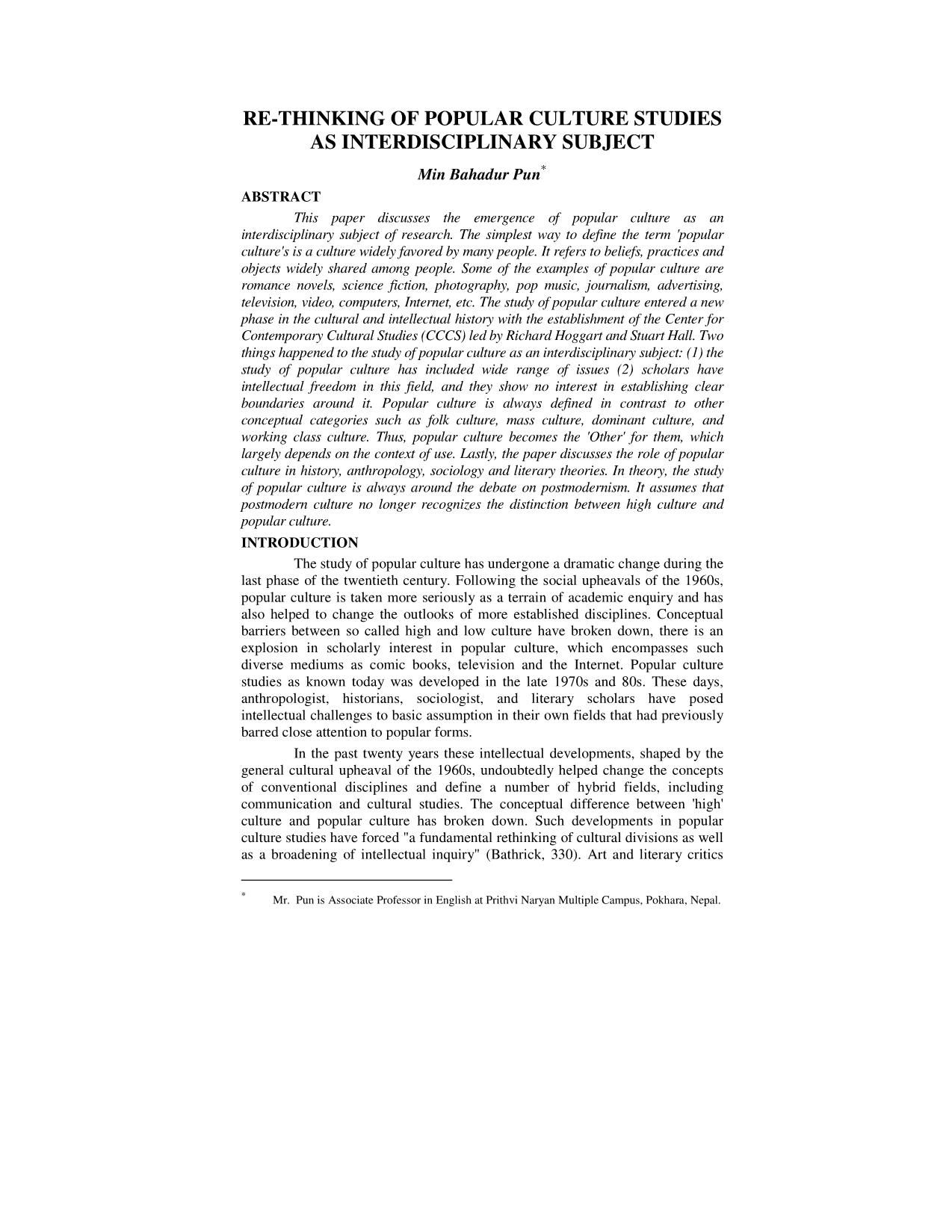
Trang 1
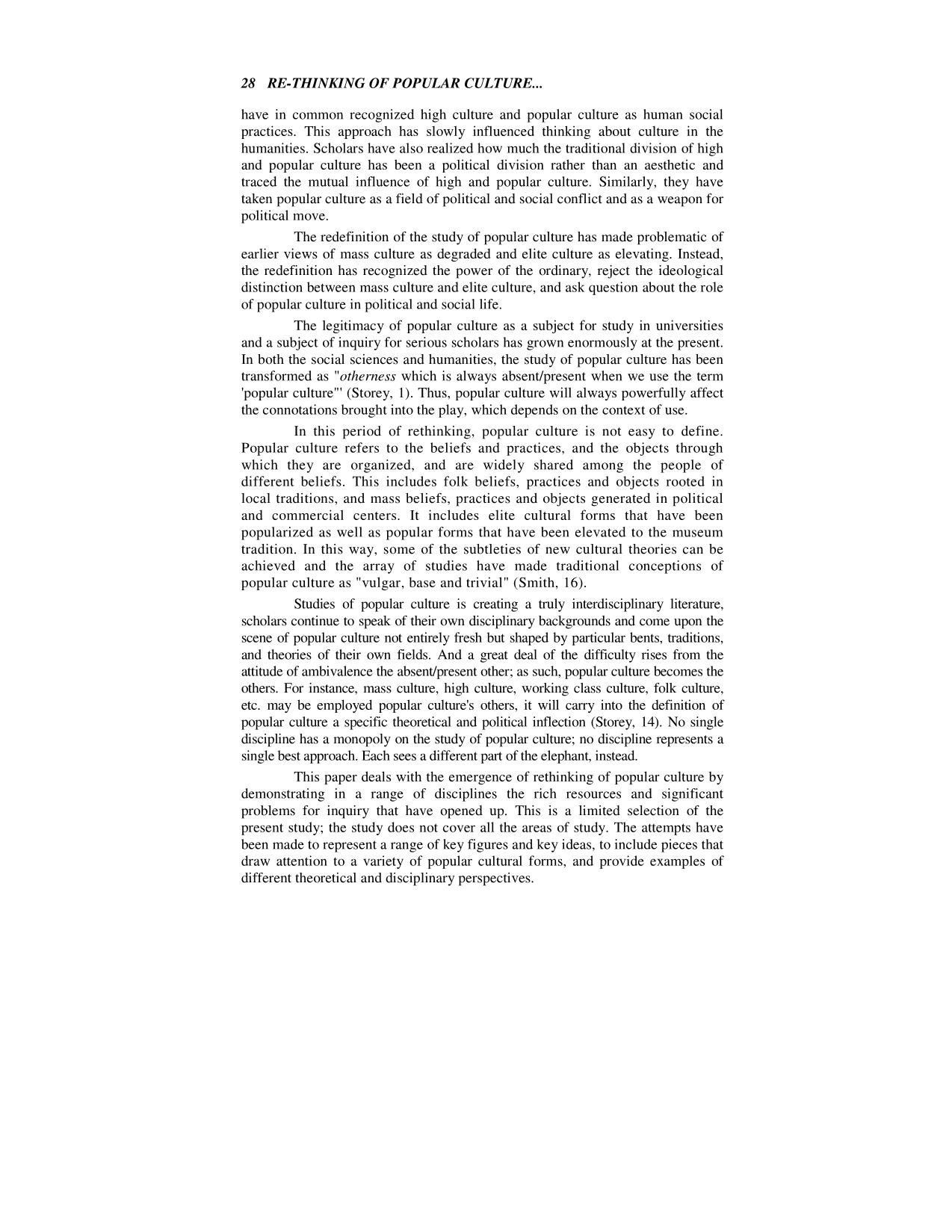
Trang 2
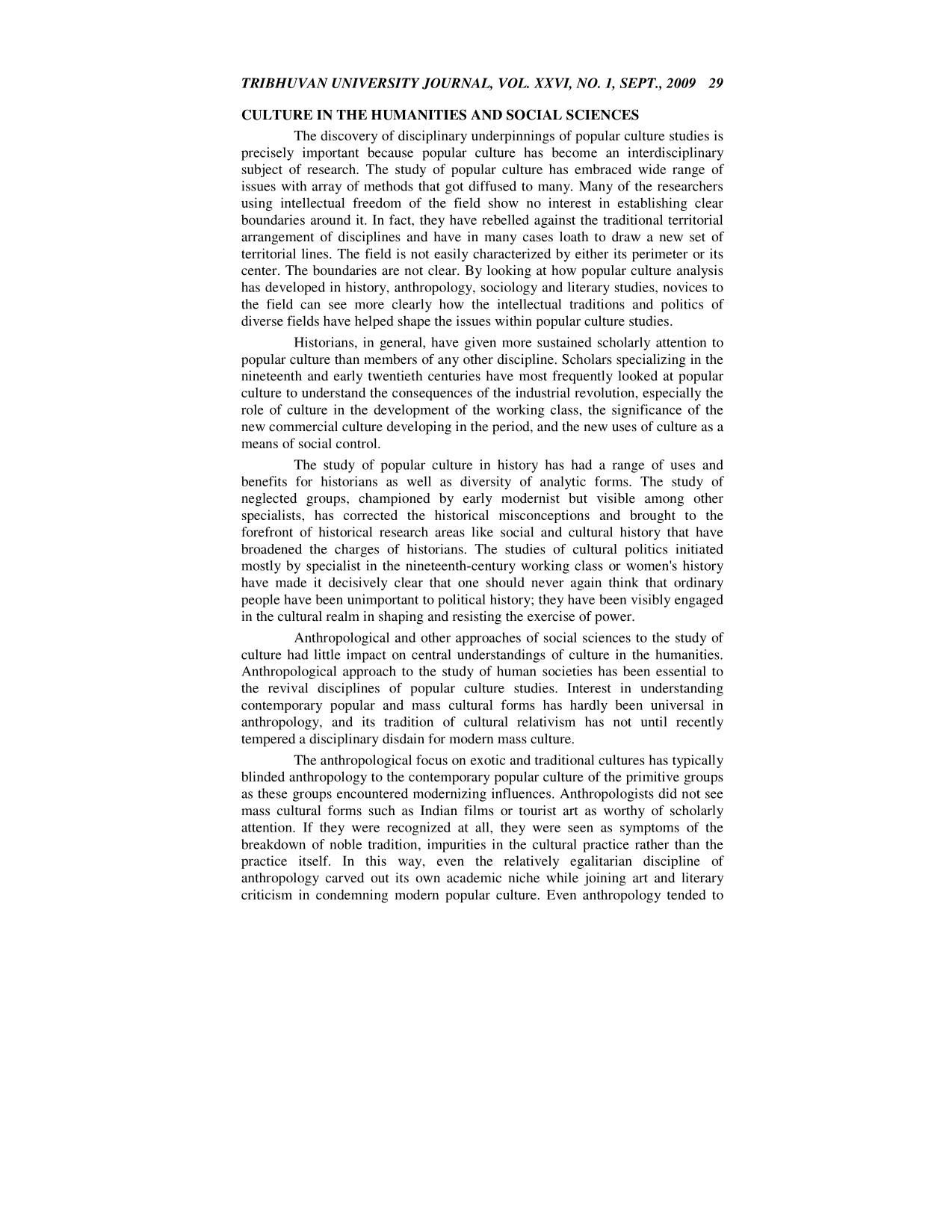
Trang 3
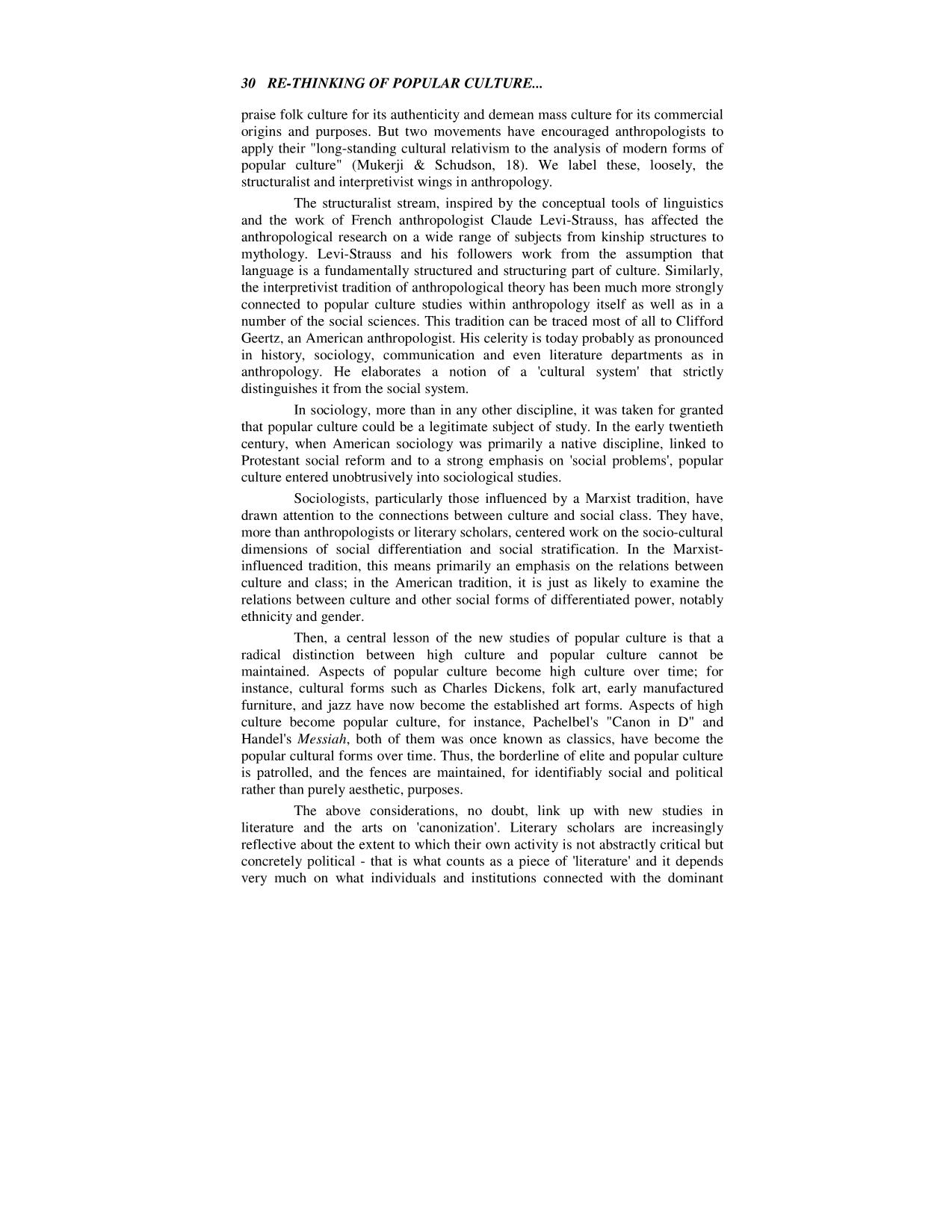
Trang 4
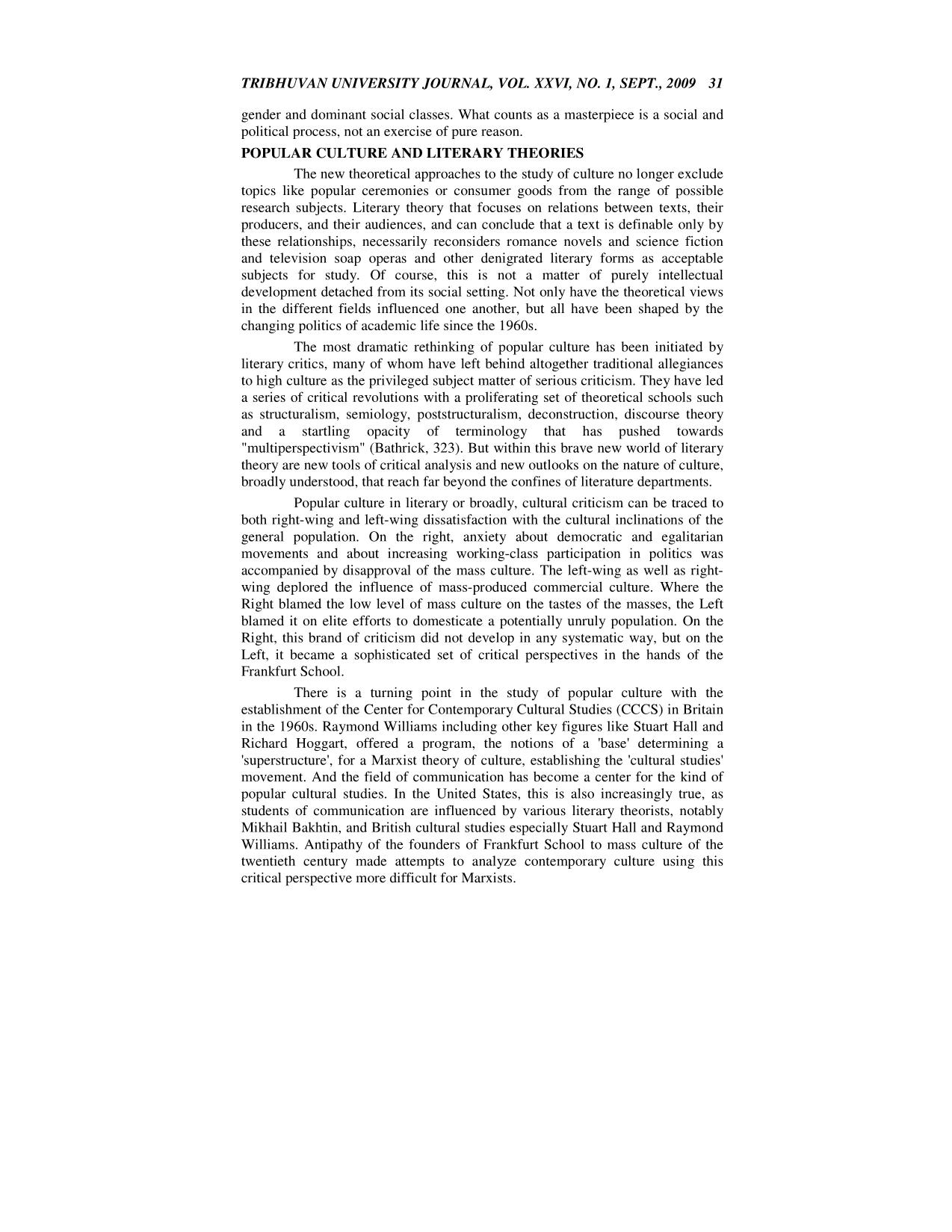
Trang 5
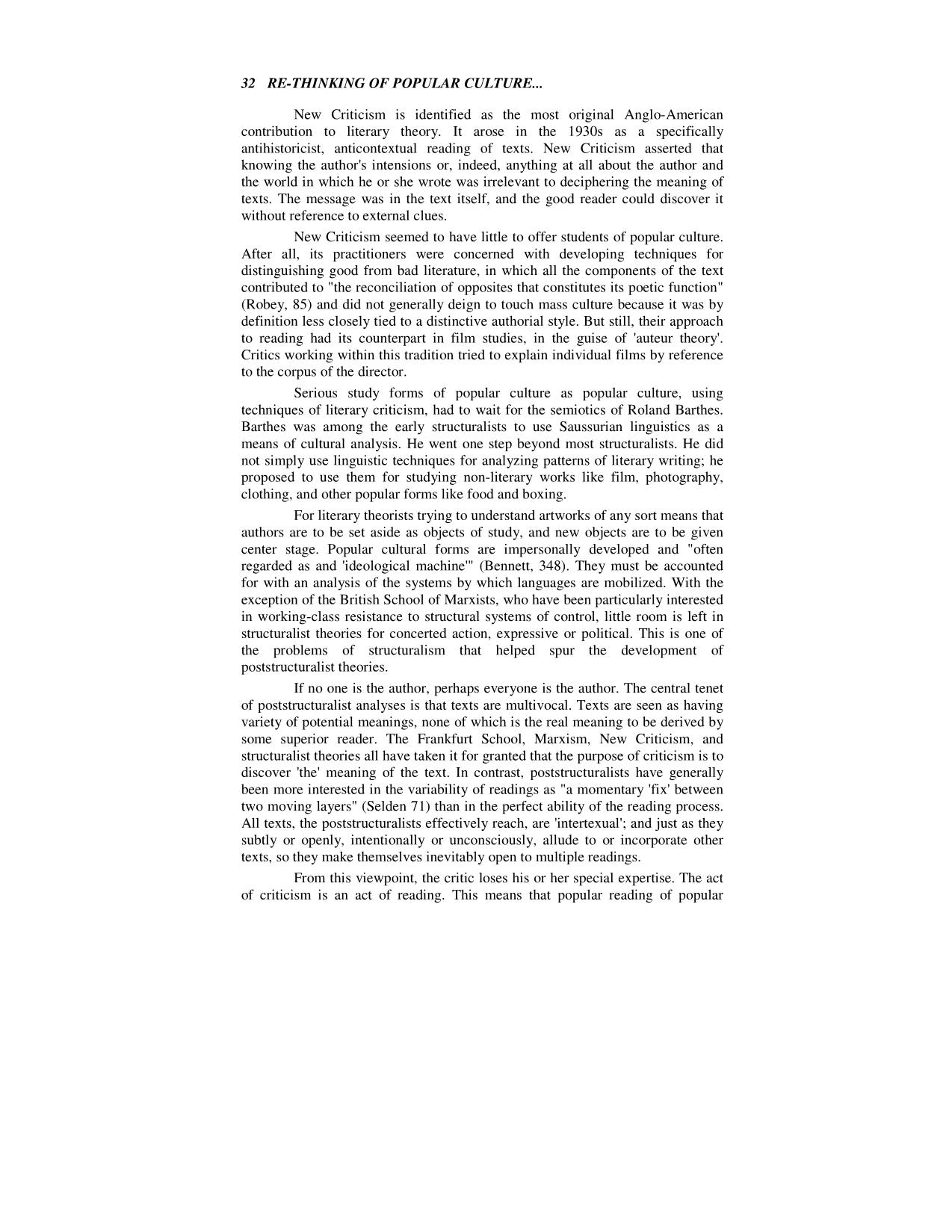
Trang 6
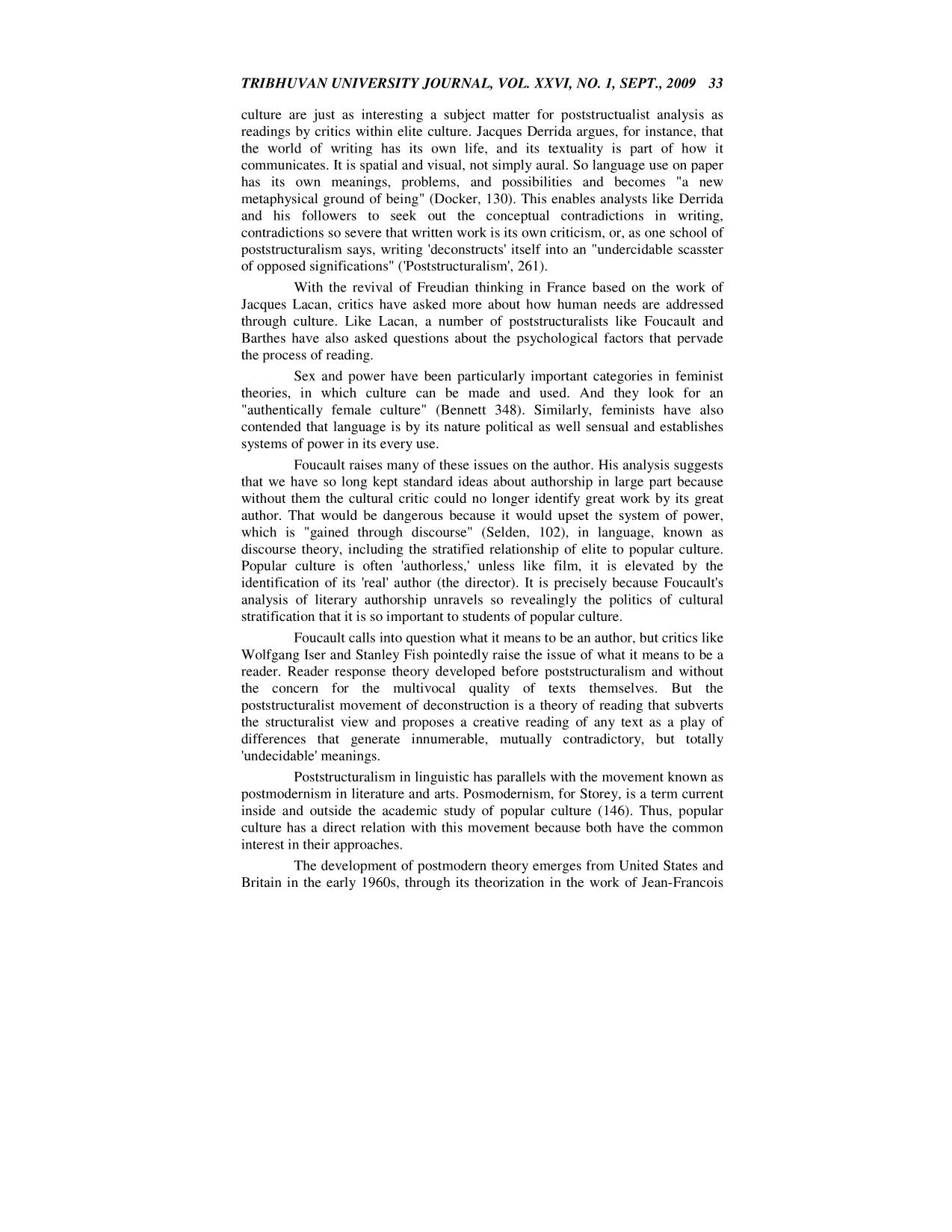
Trang 7
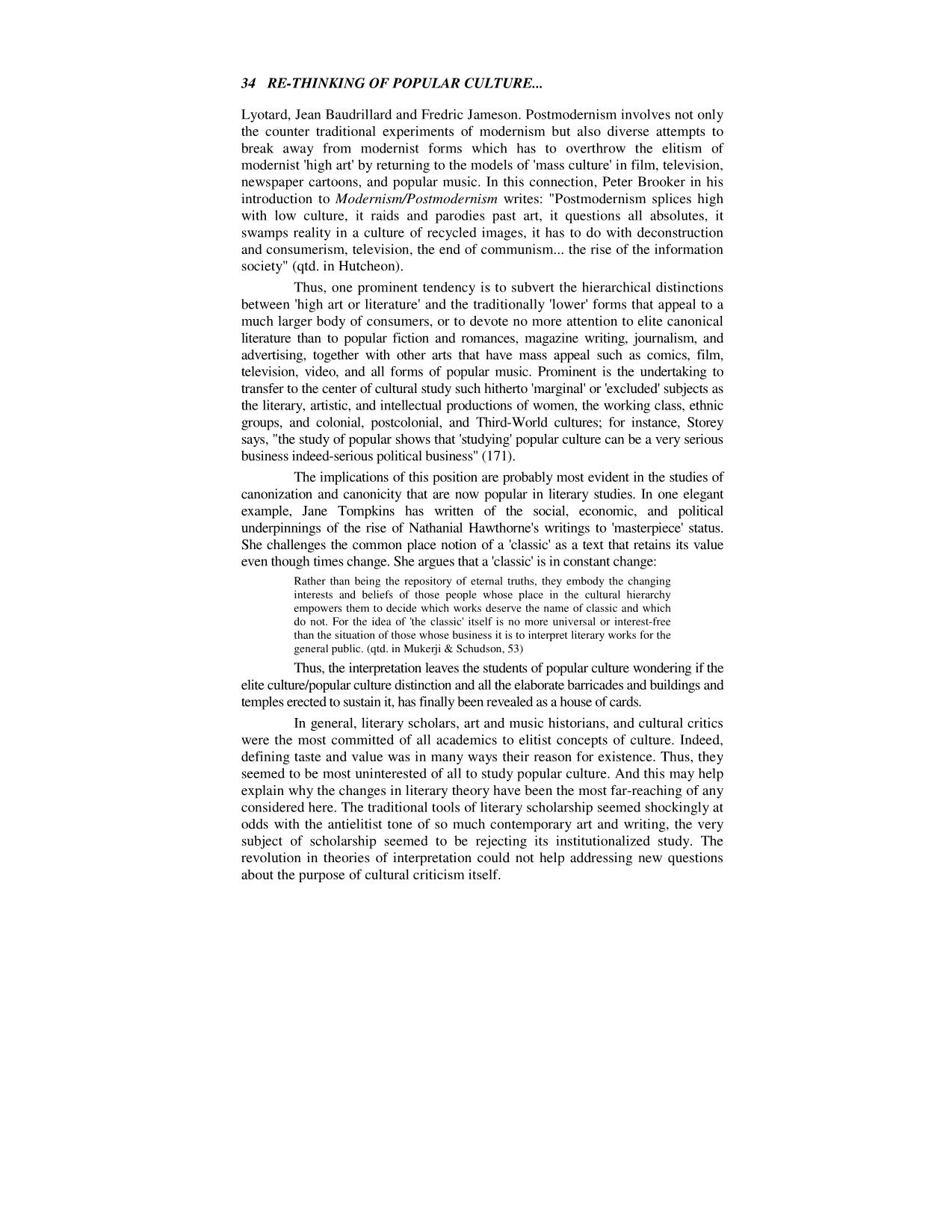
Trang 8
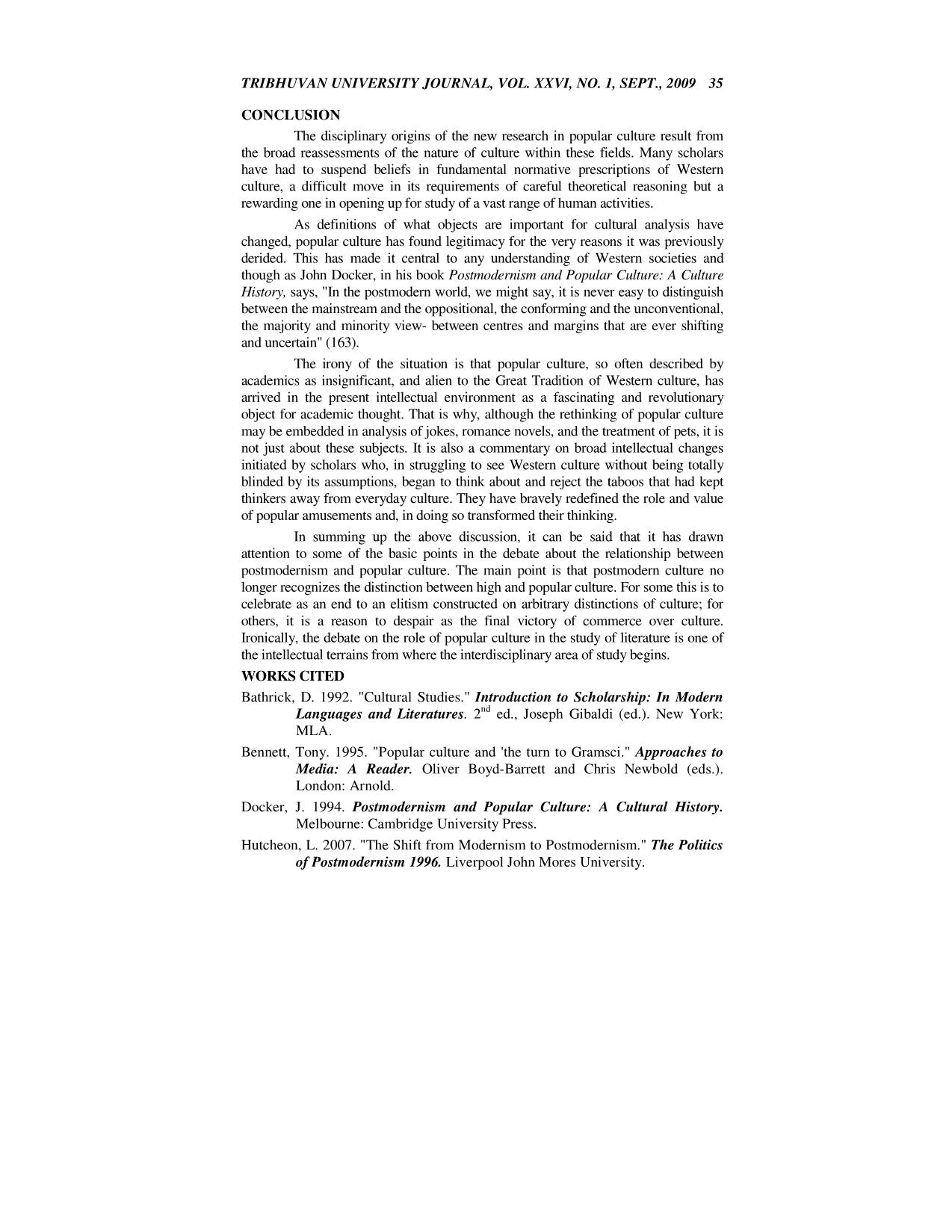
Trang 9

Trang 10
Tóm tắt nội dung tài liệu: Re-thinking of popular culture studies as interdisciplinary subject

School to mass culture of the
twentieth century made attempts to analyze contemporary culture using this
critical perspective more difficult for Marxists.
RE-THINKING OF POPULAR CULTURE...
32
New Criticism is identified as the most original Anglo-American
contribution to literary theory. It arose in the 1930s as a specifically
antihistoricist, anticontextual reading of texts. New Criticism asserted that
knowing the author's intensions or, indeed, anything at all about the author and
the world in which he or she wrote was irrelevant to deciphering the meaning of
texts. The message was in the text itself, and the good reader could discover it
without reference to external clues.
New Criticism seemed to have little to offer students of popular culture.
After all, its practitioners were concerned with developing techniques for
distinguishing good from bad literature, in which all the components of the text
contributed to "the reconciliation of opposites that constitutes its poetic function"
(Robey, 85) and did not generally deign to touch mass culture because it was by
definition less closely tied to a distinctive authorial style. But still, their approach
to reading had its counterpart in film studies, in the guise of 'auteur theory'.
Critics working within this tradition tried to explain individual films by reference
to the corpus of the director.
Serious study forms of popular culture as popular culture, using
techniques of literary criticism, had to wait for the semiotics of Roland Barthes.
Barthes was among the early structuralists to use Saussurian linguistics as a
means of cultural analysis. He went one step beyond most structuralists. He did
not simply use linguistic techniques for analyzing patterns of literary writing; he
proposed to use them for studying non-literary works like film, photography,
clothing, and other popular forms like food and boxing.
For literary theorists trying to understand artworks of any sort means that
authors are to be set aside as objects of study, and new objects are to be given
center stage. Popular cultural forms are impersonally developed and "often
regarded as and 'ideological machine'" (Bennett, 348). They must be accounted
for with an analysis of the systems by which languages are mobilized. With the
exception of the British School of Marxists, who have been particularly interested
in working-class resistance to structural systems of control, little room is left in
structuralist theories for concerted action, expressive or political. This is one of
the problems of structuralism that helped spur the development of
poststructuralist theories.
If no one is the author, perhaps everyone is the author. The central tenet
of poststructuralist analyses is that texts are multivocal. Texts are seen as having
variety of potential meanings, none of which is the real meaning to be derived by
some superior reader. The Frankfurt School, Marxism, New Criticism, and
structuralist theories all have taken it for granted that the purpose of criticism is to
discover 'the' meaning of the text. In contrast, poststructuralists have generally
been more interested in the variability of readings as "a momentary 'fix' between
two moving layers" (Selden 71) than in the perfect ability of the reading process.
All texts, the poststructuralists effectively reach, are 'intertexual'; and just as they
subtly or openly, intentionally or unconsciously, allude to or incorporate other
texts, so they make themselves inevitably open to multiple readings.
From this viewpoint, the critic loses his or her special expertise. The act
of criticism is an act of reading. This means that popular reading of popular
TRIBHUVAN UNIVERSITY JOURNAL, VOL. XXVI, NO. 1, SEPT., 2009
33
culture are just as interesting a subject matter for poststructualist analysis as
readings by critics within elite culture. Jacques Derrida argues, for instance, that
the world of writing has its own life, and its textuality is part of how it
communicates. It is spatial and visual, not simply aural. So language use on paper
has its own meanings, problems, and possibilities and becomes "a new
metaphysical ground of being" (Docker, 130). This enables analysts like Derrida
and his followers to seek out the conceptual contradictions in writing,
contradictions so severe that written work is its own criticism, or, as one school of
poststructuralism says, writing 'deconstructs' itself into an "undercidable scasster
of opposed significations" ('Poststructuralism', 261).
With the revival of Freudian thinking in France based on the work of
Jacques Lacan, critics have asked more about how human needs are addressed
through culture. Like Lacan, a number of poststructuralists like Foucault and
Barthes have also asked questions about the psychological factors that pervade
the process of reading.
Sex and power have been particularly important categories in feminist
theories, in which culture can be made and used. And they look for an
"authentically female culture" (Bennett 348). Similarly, feminists have also
contended that language is by its nature political as well sensual and establishes
systems of power in its every use.
Foucault raises many of these issues on the author. His analysis suggests
that we have so long kept standard ideas about authorship in large part because
without them the cultural critic could no longer identify great work by its great
author. That would be dangerous because it would upset the system of power,
which is "gained through discourse" (Selden, 102), in language, known as
discourse theory, including the stratified relationship of elite to popular culture.
Popular culture is often 'authorless,' unless like film, it is elevated by the
identification of its 'real' author (the director). It is precisely because Foucault's
analysis of literary authorship unravels so revealingly the politics of cultural
stratification that it is so important to students of popular culture.
Foucault calls into question what it means to be an author, but critics like
Wolfgang Iser and Stanley Fish pointedly raise the issue of what it means to be a
reader. Reader response theory developed before poststructuralism and without
the concern for the multivocal quality of texts themselves. But the
poststructuralist movement of deconstruction is a theory of reading that subverts
the structuralist view and proposes a creative reading of any text as a play of
differences that generate innumerable, mutually contradictory, but totally
'undecidable' meanings.
Poststructuralism in linguistic has parallels with the movement known as
postmodernism in literature and arts. Posmodernism, for Storey, is a term current
inside and outside the academic study of popular culture (146). Thus, popular
culture has a direct relation with this movement because both have the common
interest in their approaches.
The development of postmodern theory emerges from United States and
Britain in the early 1960s, through its theorization in the work of Jean-Francois
RE-THINKING OF POPULAR CULTURE...
34
Lyotard, Jean Baudrillard and Fredric Jameson. Postmodernism involves not only
the counter traditional experiments of modernism but also diverse attempts to
break away from modernist forms which has to overthrow the elitism of
modernist 'high art' by returning to the models of 'mass culture' in film, television,
newspaper cartoons, and popular music. In this connection, Peter Brooker in his
introduction to Modernism/Postmodernism writes: "Postmodernism splices high
with low culture, it raids and parodies past art, it questions all absolutes, it
swamps reality in a culture of recycled images, it has to do with deconstruction
and consumerism, television, the end of communism... the rise of the information
society" (qtd. in Hutcheon).
Thus, one prominent tendency is to subvert the hierarchical distinctions
between 'high art or literature' and the traditionally 'lower' forms that appeal to a
much larger body of consumers, or to devote no more attention to elite canonical
literature than to popular fiction and romances, magazine writing, journalism, and
advertising, together with other arts that have mass appeal such as comics, film,
television, video, and all forms of popular music. Prominent is the undertaking to
transfer to the center of cultural study such hitherto 'marginal' or 'excluded' subjects as
the literary, artistic, and intellectual productions of women, the working class, ethnic
groups, and colonial, postcolonial, and Third-World cultures; for instance, Storey
says, "the study of popular shows that 'studying' popular culture can be a very serious
business indeed-serious political business" (171).
The implications of this position are probably most evident in the studies of
canonization and canonicity that are now popular in literary studies. In one elegant
example, Jane Tompkins has written of the social, economic, and political
underpinnings of the rise of Nathanial Hawthorne's writings to 'masterpiece' status.
She challenges the common place notion of a 'classic' as a text that retains its value
even though times change. She argues that a 'classic' is in constant change:
Rather than being the repository of eternal truths, they embody the changing
interests and beliefs of those people whose place in the cultural hierarchy
empowers them to decide which works deserve the name of classic and which
do not. For the idea of 'the classic' itself is no more universal or interest-free
than the situation of those whose business it is to interpret literary works for the
general public. (qtd. in Mukerji & Schudson, 53)
Thus, the interpretation leaves the students of popular culture wondering if the
elite culture/popular culture distinction and all the elaborate barricades and buildings and
temples erected to sustain it, has finally been revealed as a house of cards.
In general, literary scholars, art and music historians, and cultural critics
were the most committed of all academics to elitist concepts of culture. Indeed,
defining taste and value was in many ways their reason for existence. Thus, they
seemed to be most uninterested of all to study popular culture. And this may help
explain why the changes in literary theory have been the most far-reaching of any
considered here. The traditional tools of literary scholarship seemed shockingly at
odds with the antielitist tone of so much contemporary art and writing, the very
subject of scholarship seemed to be rejecting its institutionalized study. The
revolution in theories of interpretation could not help addressing new questions
about the purpose of cultural criticism itself.
TRIBHUVAN UNIVERSITY JOURNAL, VOL. XXVI, NO. 1, SEPT., 2009
35
CONCLUSION
The disciplinary origins of the new research in popular culture result from
the broad reassessments of the nature of culture within these fields. Many scholars
have had to suspend beliefs in fundamental normative prescriptions of Western
culture, a difficult move in its requirements of careful theoretical reasoning but a
rewarding one in opening up for study of a vast range of human activities.
As definitions of what objects are important for cultural analysis have
changed, popular culture has found legitimacy for the very reasons it was previously
derided. This has made it central to any understanding of Western societies and
though as John Docker, in his book Postmodernism and Popular Culture: A Culture
History, says, "In the postmodern world, we might say, it is never easy to distinguish
between the mainstream and the oppositional, the conforming and the unconventional,
the majority and minority view- between centres and margins that are ever shifting
and uncertain" (163).
The irony of the situation is that popular culture, so often described by
academics as insignificant, and alien to the Great Tradition of Western culture, has
arrived in the present intellectual environment as a fascinating and revolutionary
object for academic thought. That is why, although the rethinking of popular culture
may be embedded in analysis of jokes, romance novels, and the treatment of pets, it is
not just about these subjects. It is also a commentary on broad intellectual changes
initiated by scholars who, in struggling to see Western culture without being totally
blinded by its assumptions, began to think about and reject the taboos that had kept
thinkers away from everyday culture. They have bravely redefined the role and value
of popular amusements and, in doing so transformed their thinking.
In summing up the above discussion, it can be said that it has drawn
attention to some of the basic points in the debate about the relationship between
postmodernism and popular culture. The main point is that postmodern culture no
longer recognizes the distinction between high and popular culture. For some this is to
celebrate as an end to an elitism constructed on arbitrary distinctions of culture; for
others, it is a reason to despair as the final victory of commerce over culture.
Ironically, the debate on the role of popular culture in the study of literature is one of
the intellectual terrains from where the interdisciplinary area of study begins.
WORKS CITED
Bathrick, D. 1992. "Cultural Studies." Introduction to Scholarship: In Modern
Languages and Literatures. 2nd ed., Joseph Gibaldi (ed.). New York:
MLA.
Bennett, Tony. 1995. "Popular culture and 'the turn to Gramsci." Approaches to
Media: A Reader. Oliver Boyd-Barrett and Chris Newbold (eds.).
London: Arnold.
Docker, J. 1994. Postmodernism and Popular Culture: A Cultural History.
Melbourne: Cambridge University Press.
Hutcheon, L. 2007. "The Shift from Modernism to Postmodernism." The Politics
of Postmodernism 1996. Liverpool John Mores University.
RE-THINKING OF POPULAR CULTURE...
36
Mukerji, C. & Michael, S. 1991. "Introduction: Rethinking Popular Culture."
Rethinking Popular Culture: Contemporary Perspectives in Cultural
Studies. Chandra Mukerji and Michael Schudson (eds.). Berkeley:
California.
"Poststructuralism." 1993. A Glossary of Literary Terms. 6th ed. By M.H.
Abrams. Bangalore: Prism Books.
Robey, D. 1986. "Anglo-American New Criticism." Modern Literary Theory: A
Comparative Introduction. 2nd ed. Ann Jefferson and David Robey
(eds.). London: B.T. Batsford.
Selden, R. 1989. A Reader's Guide to Contemporary Literary Theory. 2nd ed.
New York: Harvester Wheatsheaf.
Smith, M. J. 2002. Culture: Reinventing the Social Sciences. New Delhi. Viva.
Storey, J. 2001. Cultural Theory and Popular Culture: An Introduction. 3rd ed.
Harlow: Princeton.
File đính kèm:
 re_thinking_of_popular_culture_studies_as_interdisciplinary.pdf
re_thinking_of_popular_culture_studies_as_interdisciplinary.pdf

